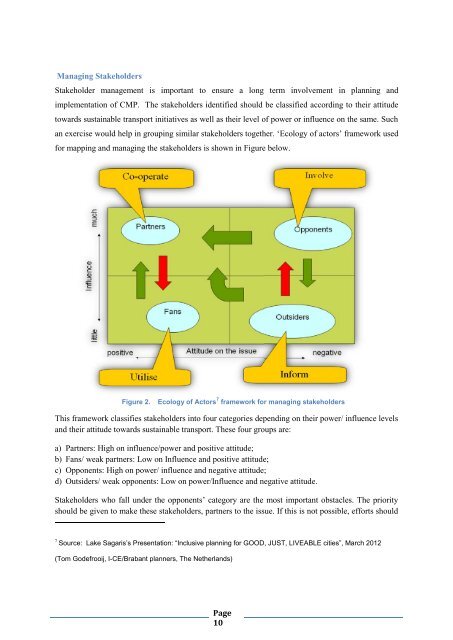Toolkits for Urban Transport Development - UNEP
Toolkits for Urban Transport Development - UNEP
Toolkits for Urban Transport Development - UNEP
You also want an ePaper? Increase the reach of your titles
YUMPU automatically turns print PDFs into web optimized ePapers that Google loves.
Managing Stakeholders<br />
Stakeholder management is important to ensure a long term involvement in planning and<br />
implementation of CMP. The stakeholders identified should be classified according to their attitude<br />
towards sustainable transport initiatives as well as their level of power or influence on the same. Such<br />
an exercise would help in grouping similar stakeholders together. ‘Ecology of actors’ framework used<br />
<strong>for</strong> mapping and managing the stakeholders is shown in Figure below.<br />
Figure 2.<br />
Ecology of Actors 7 framework <strong>for</strong> managing stakeholders<br />
This framework classifies stakeholders into four categories depending on their power/ influence levels<br />
and their attitude towards sustainable transport. These four groups are:<br />
a) Partners: High on influence/power and positive attitude;<br />
b) Fans/ weak partners: Low on Influence and positive attitude;<br />
c) Opponents: High on power/ influence and negative attitude;<br />
d) Outsiders/ weak opponents: Low on power/Influence and negative attitude.<br />
Stakeholders who fall under the opponents’ category are the most important obstacles. The priority<br />
should be given to make these stakeholders, partners to the issue. If this is not possible, ef<strong>for</strong>ts should<br />
7 Source: Lake Sagaris’s Presentation: “Inclusive planning <strong>for</strong> GOOD, JUST, LIVEABLE cities”, March 2012<br />
(Tom Godefrooij, I-CE/Brabant planners, The Netherlands)<br />
Page<br />
10
















